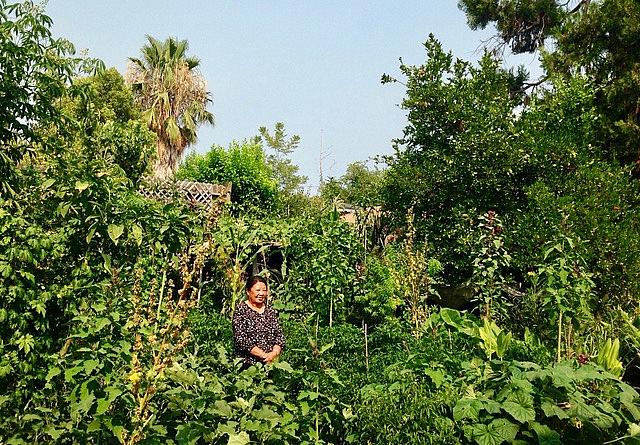A lone wolf learns the essential value of partners for reporting on refugee trauma

Mo Chao Yang sits in her garden in North Sacramento, remembering the ways she survived the secret war in Laos. (Photo: Scott Thomas Anderson)
There is no way, as an outsider, to simply parachute into a different culture and start writing about something as painfully complex as refugee trauma. It takes building trust in that community. It means starting from a place of total humility. It requires bluntly acknowledging everything you don’t know. More than anything, it demands patience, open-mindedness and a willingness to connect with people on the most basic human level.
As a learning experience, my participation in the Center for Health Journalism’s 2018 California Fellowship was something of a milestone. It was the first time in 12 years on the job I’d ever assembled an entire team to make a specific piece of journalism happen. Moreover, I had to put a tremendous amount of faith into those team members while simultaneously giving them reason to have faith in my project – and to have faith in me.
Over the last decade, I’d become extremely comfortable with being a lone wolf reporter. My curiosity honed in on potential stories. My background and institutional knowledge scouted the path for research. It was my instincts that framed the storytelling. My only collaboration, my only mediator, was with whomever was editing my work. This approach is exactly the kind of reporting scenario that big-name journalists love to idealize when speaking at conferences or being interviewed on podcasts. But it’s not always the best approach. Working on this fellowship project taught me that shedding light on important, untold stories often requires a collective brain trust.
My project sought to unravel the history of undiagnosed post-traumatic stress disorder in the Hmong elder community in California’s Sacramento and Butte counties. In the very first interview, I asked elder By Khang what he thought Americans should be more aware of when it came to the Hmong’s story. His answer was, “I want Americans to go deeper … The truth is, we really haven’t gotten to know each other.” Nothing could better summarize the issues with a lot of the past reporting on my topic.
So, the big question in front of me was how to follow Mr. Khang’s advice to go deeper. I started meeting with younger members of the Hmong community in Sacramento and Oroville. Some of the people I talked with were fellow journalists, others were community advocates, some worked in the political realm. I was looking for a wide spectrum of early input on my direction, but I was also trying to find the best partners to help me on the journey. Following the advice of a number of those who’d met with me, I began working with Vlai Ly, a Hmong-American writer and photographer who focuses his artistic lens primarily on the Hmong community; Pachia Lucy Vang, a Hmong-American ethnographer and grant recipient of the U.C. Critical Refugee Studies Collective; and Yeng Xoing, a Hmong-American social worker with a background in Hmong elder outreach. Rounding out the team was Karlos Rene Ayala, a Sacramento videographer who specializes in documenting underground and marginalized communities. Karlos is also the son of refugees from El Salvador and has a deep interest in refugee trauma.
Over the course of six months, each member of this team helped guide me through some culturally challenging aspect of the project. In many cases they helped me avoid proverbial landmines in the reporting. And in almost every case, a Hmong elder’s decision to be interviewed by me was based primarily on their trust in either Pachia or Yeng’s intentions. Once the interviews started, the elders’ openness and comfort level was also guided by the tone my translators set, along with Karlos’ ability to put them at ease while using his camera. Slowly and carefully, my team together created a rapport — and atmosphere — that allowed these elders to feel safe enough to revisit some of the most painful memories of their lives.
As an outsider to the Hmong experience, assembling the right kind of team also bought me badly needed credibility with a group who was wholly unfamiliar with my journalism. As soon as the main advocacy group in Sacramento, Hmong Youth and Parents Unite, learned that I was working with Pachia on my project, they allowed me to attend the first-ever Hmong mental health forum. I was the only person who wasn’t of Hmong heritage present in a crowd of more than 100. Attending this event turned out to be one of the most insightful and pivotal moments of my entire fellowship project.
Reporting on war and refugee trauma in marginalized communities is a daunting task for any journalist, but I’m more convinced than ever that when language barriers and culturally sensitive issues are at play, the only ethical way to approach such work is by finding research partners who come from directly from that world. You have to listen to them, be open with them, and relinquish enough control to share a journalistic vision.
The corresponding video can be viewed here.

